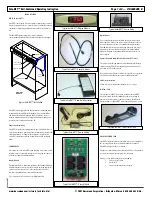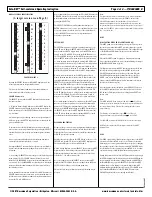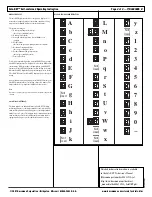
INPT
Safe-NET display module is equipped with a general-purpose digital
input. Purpose and associated actions of the input are defined in
accordance with the needs of the application and/or user requirements.
The following input definitions are available:
•
NONE
Not used.
•
ALAR
Safe-NET Alarm Module attached. Used to communicate with
the Alarm Module.
•
DFRT
Used to terminate defrost from switch input (bi-metal device;
i.e., Klixon).
•
CLEN
Clean switch. De-Activates refrigeration to the fixture and
disables high temperature alarms.
•
DOOR
Monitors door openings and closings to deactivate evaporator
fans and or alarm.
•
DUAL
Allows for dual temperature operation of cases so equipped.
Note:
Configuring the switch for operation not enabled by hardware will result
in erroneous alarms and unpredictable performance.
The Safe-NET system must be RESET for the new value to take effect.
CASE
This menu item allows the user to configure operating parameters
based on case type. Selecting the appropriate case type and then
performing a RESET on the Safe-NET system loads the default
operating parameters into the NV memory.
The Safe-NET menu system can be used to tailor these parameters to
meet specific needs. Once modified from the default setting, they will
remain active until modified by the user again.
An extra level of security has been added to this modification
procedure to further protect the operating parameters from errant
modification.
To change the case type:
Navigate to the CASE menu. Press the UP / DOWN buttons on the
Safe-NET display module until
‘NONE’
is displayed. Press the
SELECT button on the Safe-NET display module. Again use the UP /
DOWN buttons to navigate to the desired case. Press the SELECT
button on the Safe-NET display module. Then RESET the Safe-NET
display module. On RESET the Safe-NET display module will load
the appropriate default settings for the case type selected.
Always go to ‘NONE’then case type.
CLOCK MENU
This menu allows the user to set the internal Time-of-Day (TOD)
clock. This clock is a 24 hour clock that displays hours in the range
of 00 to 23. Minutes are displayed in the range of 00 to 59; i.e.,
8:00
A
.
M
. = 08.00 and 8:00
P
.
M
. = 20.00. To set the time, the valid
PASSWORD must be entered first. See the section on entering
PASSWORD for instructions on how to do this.
Enter the CLOCK menu by pressing the SELECT button on the
Safe-NET Display module until CLOC is displayed. Once the CLOCK
menu is entered, the display will cycle between CLOC and the current
time. While the time is being displayed, press the SELECT button on
the Safe-NET display module to edit the time value. The first press of
the SELECT button allows editing of the minutes. With the Safe-NET
display module flashing the minutes value, use the UP /DOWN buttons
on the Safe-NET display module to increment or decrement the
minutes to the desired value. Press the SELECT button to store the
new minutes value and begin editing the hour value. With the
Safe-NET display module flashing the hour value, use the UP /DOWN
buttons on the Safe-NET display module to increment or decrement
the hour to the desired value.
Once the desired hour is displayed, press the SELECT button on the
Safe-NET display module to store the new time. The display will now
cycle between CLOC and the new time.
To exit the menu, press the UP and DOWN buttons on the Safe-NET
Display module simultaneously.
DEFROST MENU
The DEFROST menu is used to configure defrost type and scheduling
for units whose defrost is controlled by the Safe-NET display module.
This menu also contains maintenance functions for use in manually
controlling defrost for troubleshooting and repair activity.
A relay module properly connected to defrost heaters, solenoids, etc.,
is required for the defrost cycle control function.
Refer to
SSaaffee--N
NE
ET
T
T
Teecchhnniicciiaann’’ss M
Maannuuaall
, section on Safe-NET wiring, for proper equip-
ment, techniques and safety considerations.
Note:
Changing these parameters as well as performing maintenance functions
requires that a valid PASSWORD be entered first.
DTYP
The Safe-NET system is capable of controlling defrost activity and
scheduling. The Safe-NET system is capable of controlling six types
of defrost: OffC, DET, Mod, ELE2, GAS, and ELE1.
1.
OffC
(Off-Cycle) — During off-cycle defrost, refrigeration to the
fixture is stopped by either cycling off the compressor if so equipped,
shutting off the liquid line solenoid valve, shutting off the suction
stop solenoid, or closing the EEPR if so equipped. Termination of the
defrost cycle can be configured as temperature, time, time/temperature
or via a command received from a master device when in a network
configuration.
2.
DET
— Defrost terminates when the digital input is high. This
requires the digital input of the Safe-NET display module to be
connected to the defrost termination temperature activated switch.
Defrost will terminate when the coil temperature satisfies the setting
of the termination temperature activated switch.
3.
Mod
— Modular defrost is selected to support HUSSMANN
medium temperature Impact
™
cases with modular coils installed. Each
4 foot section of coil defrosts in sequence up to 28 minutes each hour
(overridden by termination temperature if temperature is reached
before the timer expires).
4.
ELE2
— ELE2-type defrost will terminate the defrost cycle based
on time or termination temperature. The defrost heaters will
de-energize but refrigeration will not start until a command is received
from a master device. This is done to coordinate restart of refrigeration
after all cases in a system have finished their associated defrost cycle.
5.
GAS
— Not Available at this time.
6.
ELE1
— ELE1-type defrost will terminate the defrost cycle based
on time or termination temperature. The defrost heaters will
de-energize and refrigeration will start simultaneously. This type is for
stand-alone operation of low temperature units.
Note:
A relay module properly connected to defrost heaters, solenoids, etc., is
required for this control function.
STOP
To prematurely terminate a defrost cycle, navigate to the DEFROST
submenu item. The display will show STOP. While STOP is being
displayed, press the SELECT button on the Safe-NET display module.
This will terminate the defrost cycle and cause the display module to
terminate according to the programmed terminate sequence.
START
To initiate a defrost cycle, navigate to the DEFROST submenu item.
The display will show STRT. While STRT is being displayed, press the
SELECT button on the Safe-NET display module. This will initiate
the defrost cycle and cause the display module to initiate a defrost cycle
according to the programmed defrost sequence.
FCTL
The Safe-NET system is capable of controlling defrost activity and
scheduling. This menu setting determines evaporator fan operation
during defrost.
1. Selecting DTCL causes the fans to cycle in conjunction with the
defrost termination temperature activated switch. Fan operation is
inverted from the switch operation to cause the fans to be off during
defrost and on (running) after defrost termination.
2. If NONE is selected, fan control is disabled during defrost.
3. DFON causes the evaporator fans to run throughout the defrost
cycle
4. DFOF turns the fans off during defrost. The evaporator fans will
resume operation when defrost terminates from time or temperature or
after a preset coil temperature is reached. This value is set in the setup
(STUP) menu.
Note:
At least one coil temperature sensor must be installed for fan control by
coil temperature.
TSET
The Safe-NET system is capable of terminating defrost activity based
on evaporator coil temperature, return air, or discharge air. When the
Safe-NET system is configured to control defrost, the TSET setting
provides a temperature set point at which to terminate a defrost cycle.
This setting is only effective when defrost termination is set to TSEN,
RAIR or DAIR.
Note:
At least one coil temperature sensor, one discharge air sensor or one
return air sensor must be installed, and defrost termination must be
set to TSEN for this setting to have an effect.
Safe-NET™ Self-contained Operating Instruction
Page
6 of 8 — P/N 0485005_B
© 2007 Hussmann Corporation • Bridgeton, Missouri 63044-2483 U.S.A.
www.hussmann.com/cstore/c_techinfo.htm
20 June 2007


























